
Urinal, English, ca. 1500. Glass. H. 9". (Courtesy, Museum of London.) The original “Lookinge Glasse”: A green glass urinal from a Wealden glass house found in a London archaeological context.

Detail of a woodcut print, 1641. A physician tests the water of Pluto, the Papist devil, in a glass urinal. (Ernst and Johanna Lehner, Devils, Demons, and Witchcraft [New York: Dover Publications, 1971], fig. 238.)

So much for carol singers! The source of this late medieval woodcut is not known, but if it has not been redrawn, it provides one of the earliest renditions of the conventionally shaped chamber pot. (Wallace Reyburn, Flushed with Pride [London: Pavilion Books, 1989], p. 49.)

A shallow chamber pan beneath the bed of a dying man. Detail from Mortilogus, Augsburg, 1508. (Ernst and Johanna Lehner, Devils, Demons, and Witchcraft [New York: Dover Publications, 1971], fig. 182.)

Detail from Peter Bruegel the Elder’s Sloth in his series of the Seven Sins, 1557. The chamber pot beside the bed of the lazy sinners is a fully developed form with both rim-attached handle and defined foot. (H. Arthur Klein, Graphic Worlds of Peter Bruegel the Elder [New York: Dover Publications, 1971], p. 211.)

Detail from Peter Bruegel the Elder’s Charity, 1559, depicting a carefully drawn and laterally ribbed chamber pot beside a sick bed. Another, whose shape resembles that in his Sloth, hangs at the attic level where it serves as a nesting place for insect-eating swallows. (H. Arthur Klein, Graphic Worlds of Peter Bruegel the Elder [New York: Dover Publications, 1971], p. 227.)

A woodcut illustration from a ca. 1625 English ballad titled “A Statute for Swearers and Drunkards” showing a chamber pot under the tavern table. (A Pepysian Garland, edited by Hyder E. Rollins [Cambridge, Mass.: Harvard University Press, 1971], p. 109.)

Side-handled dippers. Left: Bruge, early sixteenth century. Gray proto-stoneware. H. 6 1/8". Center: Probably Bergen-op-Zoom, mid- to late sixteenth century. Lead-glazed earthenware with white-slip decoration. H. 6 1/4". Found in Bruge. Right: Bruge, sixteenth century. Lead-glazed earthenware. H. 6 1/4". (Noël Hume Collection; all photos by Gavin Ashworth unless otherwise noted.)

Side-handled dipper and chamber pot. Left: Bruge, sixteenth century. H. 6 1/4". Right: Rotterdam, sixteenth century. Lead-glazed earthenware. H. 6 3/4". (Noël Hume Collection.) Similar vessel but with the handle attached to the rim after the potter changed his mind. Note vestigial frilled foot characteristic of sixteenth- and seventeenth-century Dutch chamber pots.

Detail of the pot illustrated on the right in fig. 9 showing plugged indentation where the dipper handle should have been anchored.

Chamber pots, Netherlands, lead-glazed earthenware. Redware chamber pots from Rotterdam and Amsterdam, all with full or vestigial frilled feet. Left and right foreground: sixteenth century. H. 5 7/8" and 5 1/8". Top left: seventeenth century. H. 5 1/4". Center: Interior green-slipped and handle pinched at the crest, first half of the seventeenth century. H. 5 5/8". Top right: Angular profile and pinched handle, mid- to late seventeenth century. H. 4 3/8". (Noël Hume Collection.)

Probable redware chamber pot fragment, Southwark, London, sixteenth century. D. 6 1/2". (Ex-collection Sir David Burnett.) Note the Dutch-style frilled foot.
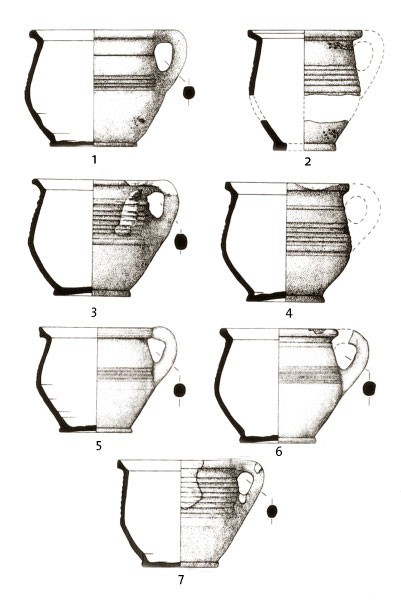
Redware chamber pot profiles from the Thomas Ward kilns at Martin’s Hundred, Virginia. (Courtesy, Colonial Williamsburg Foundation.) 1 from the fort well; 2–4 from the potter’s pond, all before 1622; 5–6 from the Ward site, ca. 1623–1635; and 7 from the Harwood plantation site but likely to be pre-massacre.

Chamber pot, Virginia, ca. 1620–1622. Unglazed earthenware. H. 6 1/4". (Courtesy, Department of Archaeological Research, Colonial Williamsburg Foundation.) Unglazed redware chamber pot from the fort well at Wolstenholme Towne in Martin’s Hundred, Virginia. See fig. 13, no. 1

Chamber pot, London, mid- to late seventeenth century. Earthenware. H. 6 1/8". (Ex-collection Sir David Burnett.) Typical London redware chamber pot with internal lead glaze and external ornamental lateral grooves similar to those on pots from Martin’s Hundred. The well-made handle is vertically channeled and squeezed at the crest, perhaps in the Dutch manner. Found in Southwark.

Chamber pot from the Harwood Plantation site at Martin’s Hundred, Virginia. (Department of Archaeological Research, Colonial Williamsburg Foundation.) Rim and wall fragment from a Rhenish gray-to-brown stoneware chamber pot, the first of its kind found in America. Recovered from an abandoned storehouse cellar, ca. 1625–1640.
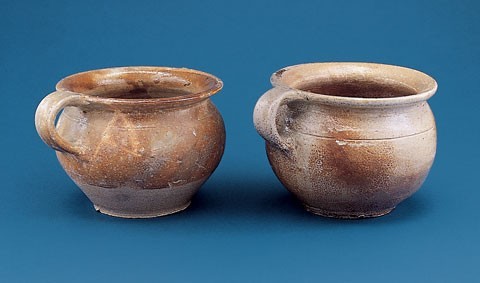
Chamber pots, Germany. Stoneware. H. 5" and 5 1/4". (Noël Hume Collection.) Excavated in Holland. Left: a close parallel for the Martin’s Hundred fragment, ca. 1625–1640. Right: Somewhat taller and more bulbous, and perhaps dating later in the seventeenth century.
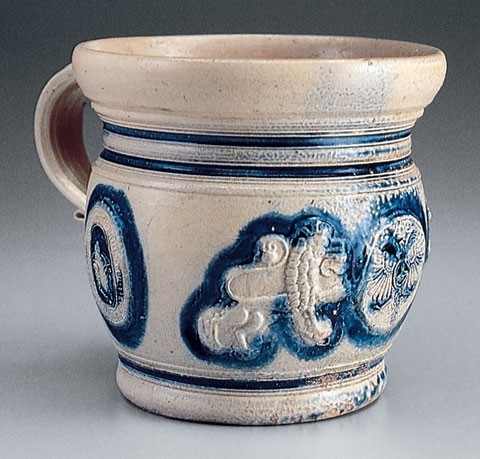
Chamber pot, Westerwald, 1632. Salt-glazed stoneware. H. 6 1/8". (Noël Hume Collection.) A gray and blue stoneware chamber pot with everted and internally dished rim, its wall decorated with sprig-applied crowned lions flanking a central double-eagle badge, and oval side medallions featuring a waist length male figure surrounded by a partially legible inscription and the date 1632. Found in Amsterdam.

Chamber pots, Westerwald, 1710–1780. Salt-glazed stoneware. H. 5 3/8". (Noël Hume Collection; ex-collection Frank Thomas.) Typical of those in the export trade from ca. 1710 to 1780. Left: decorated with sprigged lions and impressed rosettes; Right, less commonly, applied oval medallions with hatched centers. Believed to have been found together, probably in London.

Chamber pot, England, 1600–1650. Earthenware. H. 6 1/8". (Noël Hume Collection.) Border ware chamber pot of oV-white color, coated internally with a clear lead glaze in contrast to the brown run marring the exterior.

Chamber pot, Essex, England, 1650–1665. Slipware. D. 7". (Photo courtesy Jonathan Horne.) The slip inscription on this “Metropolitan” type chamber pot reads: break me not i pray in youer hast for i to non will give destast. A parallel example in the Museum of London is dated 1651.

Chamber pot, Donyatt ware, 1680–1700. Earthenware. H. 6 3/4". (Chipstone Foundation.) The lead-glazed combed slip over a buV body is in a style more characteristic of StaVordshire. The pot was retrieved from a kiln site and is considered to be a waster.

Chamber pot, North Devon, ca. 1670–1680. SgraYto slipware. H. 5 1/2". (National Park Service, Colonial National Historical Park, COLO J 7369.) The rim is inscribed under the glaze with the initials WB and 16, the rest of the date missing. Probably from a Bideford kiln.

Chamber pot, North Devon, 1660–1700. Lead-glazed earthenware. H. 7 3/4". (Chipstone Foundation.) This pot’s gravel-tempered body is internally lead glazed in mottled green and brown. A product of a Barnstaple or adjacent Fremington kiln.

Jan Steen, The Physician’s Visit, ca. 1655. Oil on panel. (Collection of the Wellington Museum [WM 1525–1948], Victoria and Albert Picture Library, London.) This painting shows a silver or pewter chamber pot, ca. 1655, beside the bed and a glass urinal in the hand of the nurse.

David Teniers, Jr., The Smokers. (Photograph and attribution provided by author.) A green-glazed chamber pot is in the right foreground. Although attributable to the mid-seventeenth century, its shape is similar to those in use in southeast England at the beginning of the eighteenth century.

Detail of the painting illustrated in fig. 26 showing chamber pot.

Chamber pot and plate fragment, England, ca. 1700–1720. Earthenware. H. 5 1/2". (Noël Hume Collection; ex-collection Sir David Burnett.) This green-glazed, buV-bodied chamber pot was common in London in the early eighteenth century, characterized by a flat, beaded-edged rim. Shown with it, a small plate of the same ware and rim characteristic; found in Southwark.

Chamber pot, London, ca. 1750. Earthenware. H. 5 1/2". (Noël Hume Collection.) Probably made in or near London in the mid-eighteenth century, this lead-glazed, redware chamber pot is characterized by a narrow and square cut rim.

Examples of redware chamber pot rims of the seventeenth and eighteenth centuries, all from a single Southwark construction site. The example at bottom left had been used as a paint pot. (Ex-collection Sir David Burnett.)

Chamber pot, London, 1820–1860. Earthenware. H. 5 1/8". (Noël Hume Collection.) Redware chamber pot internally lead glazed and characterized by a folded and rounded rim. These thick and stolid pots were often made for or used by commercial painters. This example retains traces of both white and green paint.
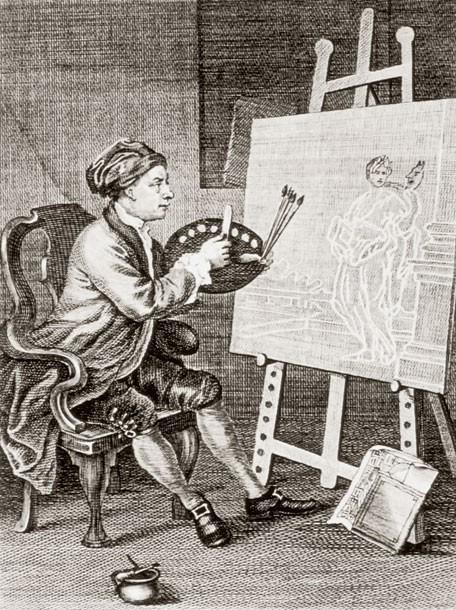
William Hogarth, self-portrait, London, 1764. Engraving. (Private collection.) The artist is shown with a paint or oil container of small chamber-pot shape beside him.
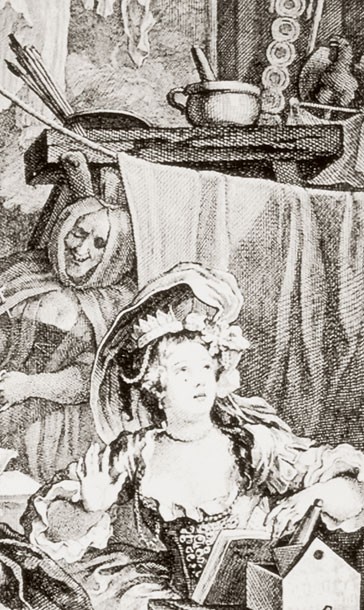
Detail of William Hogarth’s engraving, Strolling Actresses Dressing in a Barn, London, 1738. (Private collection.) This image includes a scene-painter’s chamber pot with a pestle (?) resting therein and a pallet and brushes beside it.

Chamber pot, probably France, late eighteenth century. Earthenware. H. 5 1/4". (Noël Hume Collection.) This redware pot has a thin internal lead glaze that is dirty green in color. The rim is slightly everted and folded into a weak oval profile. The missing handle (now restored) had been poorly attached and probably broke away when the pot was being emptied from a ship into the harbor at Hamilton, Bermuda.

Chamber pot fragment, London, 1650–1675. Tin-glazed earthenware. H. 4". (Ex-collection Sir David Burnett.) Delftware chamber pot of the earliest shape, the body squat, the rim flattened, and a sharp ridge at the shoulder. The biscuit (once fired) example was found on the site of Christian Wilhelm’s Pickleherring factory and dates from the third quarter of the seventeenth century.

Chamber pot, London, 1700–1725. Tin-glazed earthenware. H. 5 1/8". (Noël Hume Collection.) Delftware chamber pot attributable to the first quarter of the eighteenth century.

Chamber pots, England, 1725–1775. Tin-glazed earthenware. H. 4 5/8", 5 1/16" and 5 1/2". (Department of Archaeological Research, Colonial Williamsburg Foundation.) Examples of delftware chamber pots from excavations in Williamsburg, Virginia, illustrating their evolution from the second to third quarters of the eighteenth century. Their archaeological contexts are post 1750, ca. 1760, and none.

Chamber pot fragment, England, 1710–1730. Tin-glazed earthenware. (Department of Archaeological Research, Colonial Williamsburg Foundation.) Fragments from blue decorated delftware chamber pots found at the Timberlake and Dana site in Williamsburg, Virginia.
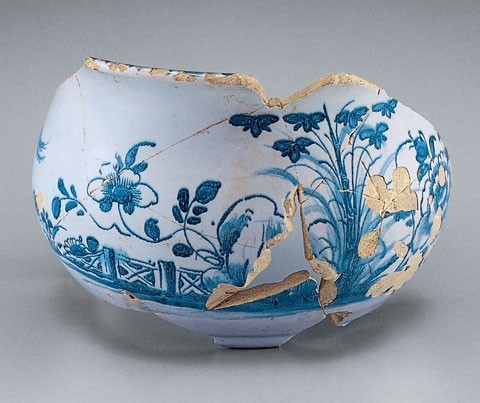
Chamber pot fragment, England, 1750–1760. Tin-glazed earthenware. (Department of Archaeological Research, Colonial Williamsburg Foundation.) Fragmentary blue decorated delftware chamber pot from the Roscoe Cole House site in Williamsburg, Virginia.

Chamber pot, Italy, 1750– 1800. Tin-glazed earthenware. H. 5 3/8". (Noël Hume Collection.) An undecorated maiolica chamber pot with everted and square-cut rim. Excavated in northern Italy.

Chamber pot, Virginia, 1750–1770. Unglazed earthenware. H. 4 7/8". (Department of Archaeological Research, Colonial Williamsburg Foundation.) This type of ware is referred to as Colono-Indian. The hand-shaped chamber pot is clearly an attempt to copy a European shape in either delftware or white salt-glazed stoneware. The reddish buV body is shell tempered. Note the lower handle terminal created from a separate pad of clay rather than having been drawn out as an extension of the handle. Discarded ca. 1770.

Chamber pot, StaVordshire, 1725–1750. Salt-glazed stoneware. H. 5 1/8". (Department of Archaeological Research, Colonial Williamsburg Foundation.) White salt-glazed stoneware chamber pot whose thinness allowed the potter to exercise his talent in a way reminiscent of Hogarth’s “Line of Beauty.” The pot came from an archaeological context of ca. 1770.

Chamber pot, StaVordshire, 1760–1780. Salt-glazed stoneware. H. 5 3/8". (Noël Hume Collection.) The white salt-glazed chamber pot in decline, its early elegance lost and the rim reduced to an everted roll.

Chamber pot, StaVordshire, 1770–1790. Salt-glazed stoneware. H. 4 11/16". (Department of Archaeological Research, Colonial Williamsburg Foundation.) English debased scratch-blue decorated white salt-glazed stoneware chamber pot, decorated in the style of Westerwald but with the addition of the GR royal initials, an impertinence that the Germans had always avoided.

Chamber pot, Staffordshire, 1760–1775. Salt-glazed stoneware. H. 4 3/4". (Alexandria Archaeology Museums, City of Alexandria, Virginia; photo courtesy Richard Muzzrole.) A similar pot somewhat better painted and decorated with a profile portrait of George III flanked by his GR initials. Found in an Alexandria privy in an early-nineteenth-century
context.

Chamber pot, England, 1775–1800. Creamware. H. 5 5/16". (Department of Archaeological Research, Colonial Williamsburg Foundation.) Undecorated English creamware chamber pots were exported in large numbers. This typical example from Williamsburg excavations features a flat rim and a simple strap handle. Others were more elaborate and came laterally ribbed and with rolled rims.
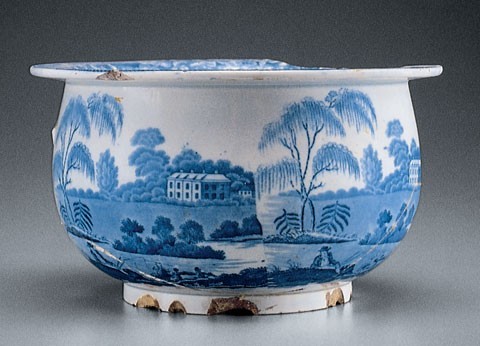
Chamber pot, StaVordshire, 1810–1820. Pearlware. H. 4 7/8". (Ex-collection Sir David Burnett.) Blue transfer printed with a widely used print of Nuneham Court in Oxfordshire.
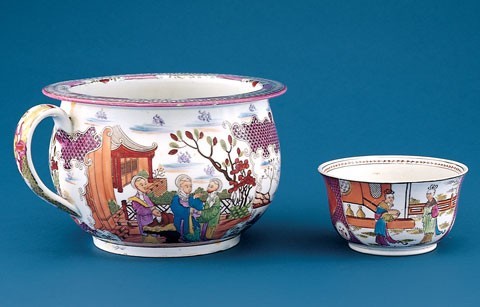
Chamber pot and bowl, Staffordshire, 1800–1810. Pearlware. H. 5 3/16" and 2 5/8". (Noël Hume Collection.) A chamber pot elaborately decorated with a black-transfer print intended as guidance for complex polychrome hand painting in the Chinese manner. Accompanying the chamber pot is a similarly decorated bowl whose very shallow foot suggests that it may have been intended as a shaver’s soap dish.

View of the chamber pot illustrated in fig. 48. This interior is richly hand painted onto a transfer design copying that on a bone china plate from the factory of Miles Mason of Lane End, ca. 1805.

Chamber pot, Sunderland, 1830–1850. Pearlware. H. 5". (Private collection.) A double-handled, transfer-printed and hand colored chamber pot designed as a humorous wedding gift. Such pots were relatively common, but their distribution is likely to have been restricted to the rural north of England, such humor not being appreciated in an increasingly straight-laced Victorian urban south. There are several minor variations, some with Sunderland’s characteristic luster adornments. As shown in figures 51 and 52, the interior print came as viewers either young or old, perhaps reflecting the age of the newlyweds. Frogs also were optional.

Detail of the interior of the chamber pot illustrated in fig. 50.

Interior view of the Sunderland chamber pot illustrated in fig. 54. (Noël Hume Collection.)
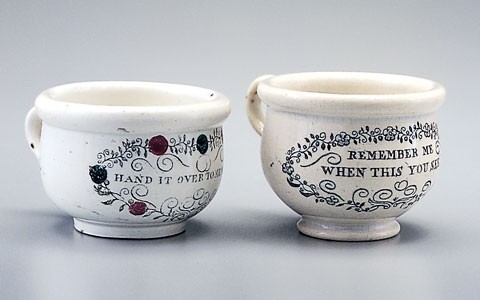
Miniature chamber pots, 1840–1870. Whiteware. H. 2 1/2" and 2 1/4". (Noël Hume Collection.) Each has a transfer-printed inscription. Both were almost certainly made for sale at fairgrounds or they may have been given away as inducements to purchase more necessary wares.
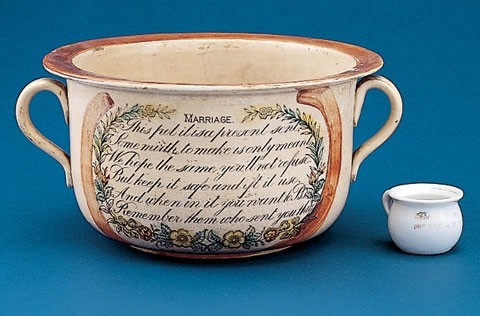
Miniature chamber pot marked germany, early twentieth century. Porcelain. H. 1 5/8". (Noël Hume Collection.) The side has a gilded inscription reading: there are times when / one desires to be alone. The interior bottom is enriched with a transfer-printed and hand-colored human eye beneath a gilded inscription reading “Goo Goo.” The full sized pot is included for scale but shows the reverse side of fig. 52.

Interior view of the miniature chamber pot illustrated in fig. 54.

Chamber pot, England, ca. 1935–1940. Whiteware. H. 5 1/4". (Noël Hume Collection.) Decorated with a weak polychrome floral print on one side. A black eye is printed inside and the rim inscribed good companion anti spash thunder bowl. Marked “Made in England.”

Chamber pot, miniature, Lancaster Ltd., Hanley, England, 1939–1940. Whiteware. H. 1 1/2". (Noël Hume Collection.) A morale-building, humorous toy printed internally with a profile of Adolf Hitler and inscribed both inside and out adolf in poland. Maker’s mark on base.
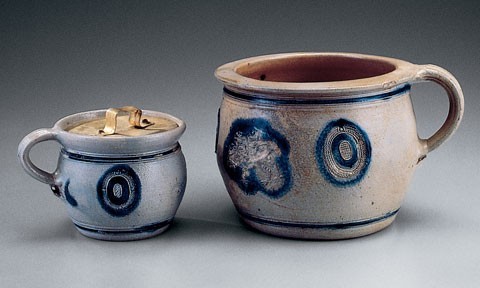
Soap dish and lid, Germany, ca. 1750. Salt-glazed stoneware. H. 3 3/4". (Noël Hume Collection.) Westerwald gray and blue stoneware vessel of small chamber pot shape, but thought to have been intended as a shaver’s soap dish. The sprigged cartouche parallels those on some full-sized Rhenish chamber pots like the example on the right. Both the pot and its brass lid were found in situ in an Amsterdam privy.

A loop-handled Westerwald stoneware parallel for figure 58 found by diver-conservator William Gillies on an unidentified Bermuda shipwreck of ca. 1740–1750. H. approx. 3 5/8". (Courtesy, William Gillies.)

Miniature chamber pot, Netherlands, 1700–1730. Tin-glazed earthenware. H. 3". (Noël Hume Collection.) A full sized chamber pot illustrated in figure 36 is included for scale next to the Dutch delftware vessel of chamber-pot shape.

Chamber pot, StaVordshire, ca. 1825. Stone china. H. 5 3/4". (Noël Hume Collection.) This chamber pot was cast in a two-piece mold whose junction lines have not been removed; it is transfer printed in blue overlaid in hand-applied red. The chinoiserie pattern is reproduced internally, and the exterior rim and shoulder are molded in a bead-and-reel design reminiscent of white salt-glazed stoneware plate rims. The elaborately molded and gilded handle is enriched with a separately applied upper terminal. The base is marked with the kind of badge allowed to companies that had been granted its usage by Royal Appointment.

Detail of the printed mark on the base of the chamber pot illustrated in figure 61. The associated inscription declares itself to be that of a manufacturer of ROYAL STONE CHINA from the factory of R. S. & W. The company is believed to be that of Stevenson and Williams, a short-lived Cobridge partnership of ca. 1825, but there is no known evidence that it enjoyed royal patronage. The English royal arms are charged with the cap or crown of Hanover and therefore date prior to the accession of Queen Victoria in 1837.

Chamber pots, American, 1790–1810. Salt-glazed stoneware and lead-glazed earthenware. H. 6 3/4" and 6 1/4". (Courtesy, Department of Archaeological Research, Colonial Williamsburg Foundation.) Examples of American chamber pots used in the lunatic asylum at Williamsburg, Virginia, ca. 1790–1810. The redware pot is possibly from the factory of Henry Piercey in Alexandria, whereas the stoneware example is likely to have been made either in Philadelphia or Baltimore.

Chamber pot, England, ca. 1838. Whiteware. H. 5 15/16". (Courtesy, Department of Archaeological Research, Colonial Williamsburg Foundation.) This chamber pot was initialed specifically for the Williamsburg Lunatic Hospital whose name was changed in 1838. Believed to be English, but the initials may have been added by an American importer.

Chamber pots, England, 1860–1885. Whiteware. H. of tallest: 5 7/8". (Courtesy, Department of Archaeological Research, Colonial Williamsburg Foundation.) Three among several fire-blackened, heavy-duty ironstone-type chamber pots found in the debris of the 1885 fire that destroyed the Williamsburg asylum.

Detail from an engraving illustrating Jonathan Swift’s A Tale of a Tub (1751 edition), showing the chamber pot as a means of expression.
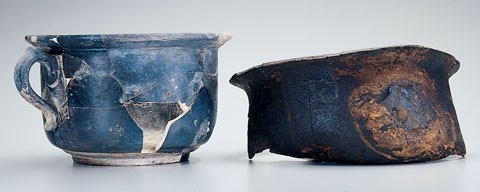
Chamber pots, England, ca. 1880. Whiteware and vulcanized rubber. H. 5 3/8". (Courtesy, Department of Archaeological Research, Colonial Williamsburg Foundation.) Another ironstone-type chamber pot from the Williamsburg asylum’s 1885 fire shown alongside the remains of a vulcanized chamber pot intended for the use of unruly patients.

Print from a glass negative. (Courtesy, David Doody and the Image Alchemy Inc. Collection.) This photograph, perhaps shot in a New Orleans flop house, shows typical turn of the twentieth-century chamber pots more or less in use. Note the ghost image of one of the room’s occupants seated on the bed.
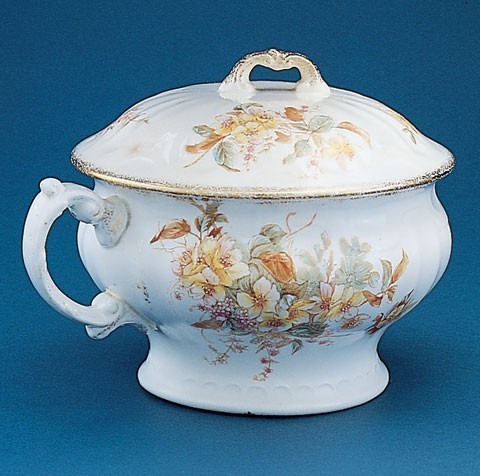
Chamber pot and lid, Maddock’s Lamberton Works Royal Porcelain, Trenton New Jersey, ca. 1892. H. 5 3/4". (Noël Hume Collection.) A massive, lidded chamber pot of hotel-china whiteware, gadroon molded and decorated with transfer-printed polychrome floral sprays and spatter gilding. Though mold-made, the marks have been almost entirely erased. There are tripod stilt marks scarring the interior base suggesting that the pot was fired upside down.

Catalog illustration, Messrs. Higgins & Seiter, New York, 1899. In the late nineteenth century chamber pots were commonly sold in sets of a dozen, though social sensitivity kept them from being pictured in the ads.

Chamber pots, England, ca. 1880 and 1900. Whiteware. H. 5 3/4" and 5 1/2". (Noël Hume Collection.) Examples of diverse late Victorian chamber-pot taste. The left hand cream-colored example is molded below the girth with a basketry pattern that continues onto the unusual bifurcated handle. The upper wall and rim are transfer printed in sepia in an elaborate pattern of storks, fans, twigs, flowers, and a boy apparently pursuing a butterfly. However, the pattern is inverted and presumably intended to complement an equally decorative lid. No maker’s mark, but printed with a diamond-shaped design registration mark for August, 1880. The pot recalls the enthusiasm for Japanese textiles and ceramics that burgeoned in the late nineteenth century. The unmarked example on the right is a whiteware reminder of a paralleling taste for contrasting colors and fluid lines loosely related to the art nouveau movement.
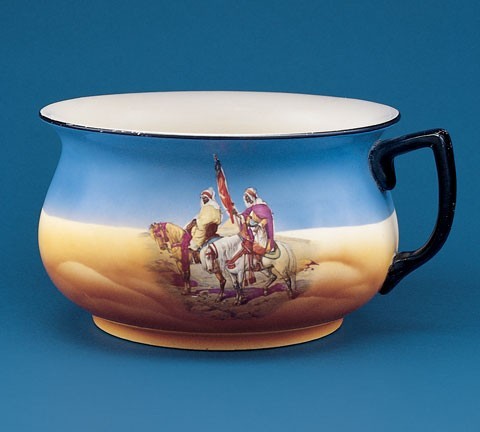
Chamber pot, England or possibly North Germany, ca. 1920–1930. Whiteware. H. 5 1/4". (Noël Hume Collection.) Titillating dreams of Bedouin tents, Arab sheiks, and fates definitely not worse than death, may have been fostered by transfer-decorated pots like this from the 1920s.

“Just in Time.” Hogarth would have called this a “Tail Piece.” (Mary Evans Picture Library.)
